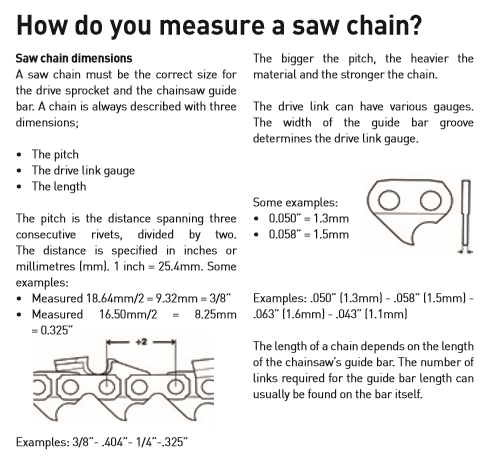- Saw Chain 41BO 91COP 22ABL 59AU 73AR
- Guide Bar K095188D124L72 D025163C115R60 D025240C00H84 A041140A00V48
- Sprockets SS-S066 SS-3800 RS-H365 PKSM325-7
- Professional Tools Sharpener File Wrench Chain Breaker/Spinner

(1) The saw chain has to be forced to cut by applying pressure to the engine unit. It does not pull itself into the wood.
(2) The saw starts to produce fine sawdust instead of chips or coarse strands.
(3) Smoke develops in or around the cut, even though the chain lubrication is in working order and the chain tension is correct.
(4) The cut is crooked and the chainsaw wanders in one direction. This is an indication of dull cutting teeth on one side of the chain or uneven cutting teeth lengths.
(5) It is difficult to achieve precise positioning. The chainsaw “rattles” and “bounces” during the cut.
If you want your chiansaw to deliver the best cutting performance each and every time and to enjoy a long service life as well, you should make sure to do several key things.
Regularly clean the sprocket nose, the oil inlet hole and the oil the bar groove and the cooling fins.
Rotate the guide bar and remove burrs from the guide bar (if necessary) after each time you change or sharpen the chain.
Check the chain tension on new chainsaws once you have worn them in and never work without lubricating your chain!
I did want to explain saw chain sharpening, because my sense is that the casual saw user finds this daunting, and at the same time, underestimates its importance. I know people who will just stop using a dull saw, or will go out and buy a new chain every time the old one becomes dull. That’s $20 wasted! A sharp saw is a pleasure to use; much more effectual, safer, and less tiring. Consider trying to carve a roast beef with a butter knife, then picking up a carving knife to do the job. what was I thinking?
A saw chain has cutters and rakers. The cutter is the part that cuts – duh! – then severs the wood fibers, and has to be sharp to be effective. The raker controls the depth of the cut, and must be filed down as the cutters wear over time.
Here are two file guides that are simple and cheap. The first is a file holder that rests on top of the cutters so that the round file itself is positioned on the cutter correctly . What you, need to do is hold the file guide slightly downward (usually 10o, but check the manual or saw chain package) and at the proper angle marked on the file guide and on the cutter itself (usually 25 o or 30o, but, again, check the manual or saw chain package). File from the inside of each cutter to the outside, and file in one direction only, away from you. Each cutter should get 5-10 strokes of the file (for whatever reason, I always count eight) then be checked for sharpness.
The second file jig or roller guide sits on the links of the chain, which hold it at the correct position and angle. The round file is passed over the plastic roller and sharpens the cutter. Sharpen all the cutters on one side of the chain, spinning the chain as you go, then sharpen the other side’s cutters. Some people squat over the saw on the ground; some people clamp the saw in a vice in the workshop; I find that the tailgate of my truck is a comfortable height. Sharpening may seem complicated, or as intricate as mastering the French horn, and that it would take hours, but a credible sharpening job can be done in 10 or 15 minutes. Just remember to check the size of file needed, and the filing angles, for your particular saw chain.
The height of the rakers needs to be slightly less than that of the cutters, and that difference is critical. Too little and the cutters will just ride over the wood without cutting, too much and the saw will become jumpy and erratic. Every three or so cutter sharpenings, the depth of the rakers should be checked with a depth gauge, and filed and rounded off as needed.
Your guide bar's length is represented by the cutting length (or "called length"), which is different from its total or overall length. The cutting length is the distance from the front of the saw to the tip of the guide bar, rounded to the nearest inch.

Because the chain and bar operate together as a team, a few simple practices can make them both run efficiently.
(1) Keep your cutters sharp and touch them up frequently.
(2) File the cutters evenly. Be sure the filing angles are the same on the left and right sides.
(3) Keep your depth gauges even on both sides of the chain and at their recommended settings.
(4) Use plenty of bar and chain oil. Oil is cheaper than either a new bar or chain!
(5) Remove the bar periodically and clean accumulated sawdust from the oil hole and bar groove. Turn the bar over regularly.
(6)Tension the chain properly, just tight enough to be able to pull around the bar by hand. Check the tensioning frequently, but not while the chain is hot; wait until the chain is cool to the touch.